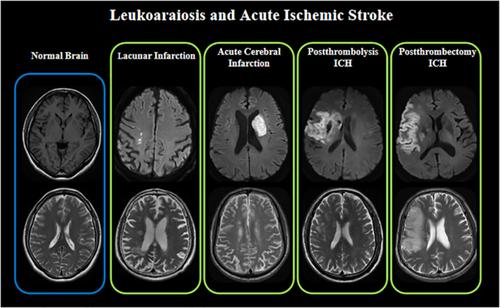当前位置:
X-MOL 学术
›
Eur. J. Nerosci.
›
论文详情
Our official English website, www.x-mol.net, welcomes your feedback! (Note: you will need to create a separate account there.)
Leukoaraiosis and acute ischemic stroke
European Journal of Neroscience ( IF 3.4 ) Pub Date : 2021-07-31 , DOI: 10.1111/ejn.15406 Xiaojia Tang 1 , Li Jiang 2 , Yuhan Luo 3 , Hongyang Fan 4 , Lilong Song 5 , Peipei Liu 2 , Yingzhu Chen 2
European Journal of Neroscience ( IF 3.4 ) Pub Date : 2021-07-31 , DOI: 10.1111/ejn.15406 Xiaojia Tang 1 , Li Jiang 2 , Yuhan Luo 3 , Hongyang Fan 4 , Lilong Song 5 , Peipei Liu 2 , Yingzhu Chen 2
Affiliation

|
Ischaemic stroke is characterized by high morbidity, high disability rate, high mortality and high recurrence rate, which can have a grave impact on the quality of life of the patients and consequently becomes an economic burden on their families and society. With the developments in imaging technology in recent years, patients with acute cerebral infarction are predominantly more likely to be diagnosed with leukoaraiosis (LA). LA is a common degenerative disease of the nervous system, which is related to cognitive decline, depression, abnormal gait, ischaemic stroke and atherosclerosis. The aetiology of LA is not clear and there is no gold standard for imaging assessment. Related studies have shown that LA has an adverse effect on the prognosis of cerebral infarction, but some experts have contrary beliefs. Hence, we undertook the present review of the literature on the mechanism and the effect of LA on the prognosis of patients with acute ischaemic stroke.
中文翻译:

脑白质疏松症和急性缺血性中风
缺血性脑卒中具有高致残率、高致残率、高死亡率和高复发率的特点,严重影响患者的生活质量,成为家庭和社会的经济负担。近年来,随着影像技术的发展,急性脑梗死患者更容易被诊断为脑白质疏松症(LA)。LA是一种常见的神经系统退行性疾病,与认知能力下降、抑郁、步态异常、缺血性中风和动脉粥样硬化有关。LA 的病因尚不明确,也没有影像学评估的金标准。相关研究表明,LA对脑梗塞的预后有不利影响,但也有专家持相反观点。因此,
更新日期:2021-09-21
中文翻译:

脑白质疏松症和急性缺血性中风
缺血性脑卒中具有高致残率、高致残率、高死亡率和高复发率的特点,严重影响患者的生活质量,成为家庭和社会的经济负担。近年来,随着影像技术的发展,急性脑梗死患者更容易被诊断为脑白质疏松症(LA)。LA是一种常见的神经系统退行性疾病,与认知能力下降、抑郁、步态异常、缺血性中风和动脉粥样硬化有关。LA 的病因尚不明确,也没有影像学评估的金标准。相关研究表明,LA对脑梗塞的预后有不利影响,但也有专家持相反观点。因此,


























 京公网安备 11010802027423号
京公网安备 11010802027423号